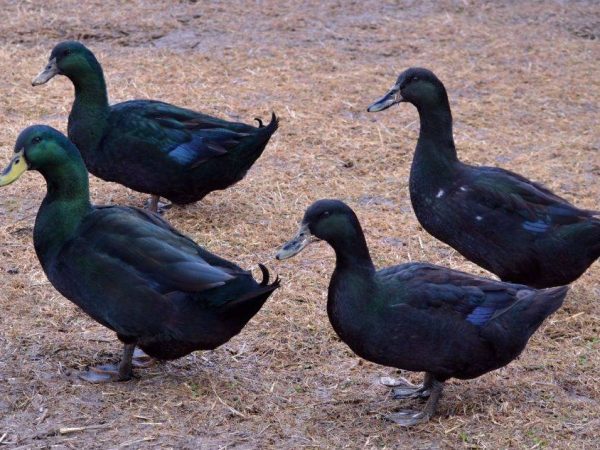Cayuga duck feature
Bred back in 1874, the American Cayuga duck (Cayuga) quickly gained popularity among farmers and continues to use it to this day. We have to admit that this is quite natural, because this bird has many undeniable advantages. So, she is able to boast of excellent quality meat and high egg production, which is extremely important for any owner. In addition, this duck has another obvious plus: a spectacular appearance, thanks to which the cabbage is often kept as a decorative bird.

Cayuga ducks
As for the very peculiar name of the breed in question, it comes from the lake of the same name, located in the American state of New York. It was there, almost 1.5 centuries ago, that this duck was first presented, rightfully considered one of the most beautiful representatives of its biological species. If we highlight its most characteristic feature, then such is the color scheme: black with green and blue tints, thanks to which the kayuga stands out very noticeably against the general background.
Description of the main characteristics
Talking about cabbage ducks, it is worth noting that they belong to the medium-heavy type. This is confirmed by the weight characteristics of adult males and females belonging to this breed, which are 3.5-4 and 2.9-3.1 kg, respectively. As for other notable features of these birds, the list of the most significant of them is presented below:
- rather strong physique;
- paws and beak are deep black without any impurities;
- eyes have a dark brown tint;
- the length of the lower limbs and tail (the latter is directed upwards) is average;
- the wings are very tight to the body;
- a noticeably arched neck, the length of which is relatively short.
The description of these ducks says that at present there are two directions to which the kayugi can belong: the first is characterized by a prevailing green tint of the plumage, and the second is blue. Each of the listed species looks very aesthetically pleasing, which is confirmed by the huge mass of photos of these remarkable birds presented on the vast expanses of the Internet.
The nature and lifestyle of the kayuga
Continuing the description of ducks belonging to the breed in question, special attention should be paid to the features of their character. So, they behave very calmly: they grunt infrequently and behave peacefully in relation to the surrounding birds. Also worthy of mention is the discipline inherent in kayugas: thanks to it, they can be safely left to graze on the lawn unattended, without fear that they will scatter throughout the district. It is also noteworthy that these ducks are happy to eat insect pests, while not harming the plants planted by the owners.
Another equally significant feature of the kayuga is the ability to master in a variety of climatic conditions. Practice shows that these birds feel equally well both in southern and temperate latitudes.Due to their unpretentiousness, they can easily hibernate in poultry houses at temperatures as low as 5 ° C, without feeling any discomfort if the floor of their home is covered with a layer of straw. For this reason, it is quite possible to keep them in the countries of the post-Soviet space, for most of which a gentle winter is completely unusual.
Power features
As mentioned above, the musher can hardly be called a finicky bird. This thesis is also true in everything that concerns the nutrition of such ducks, which is not distinguished by any complexity. If we single out those ingredients that are first of all recommended to be included in the diet of these birds, then their list is as follows:
- various greens;
- finely ground wheat and corn;
- mash, steamed on dairy products or meat broths.
Food of animal origin, namely insects, should be added to the diet of the ducks. As a rule, for this it is enough just to give the birds the opportunity to regularly walk in the beds - in such cases, they can easily find their "arthropod delicacies" on their own.
Provided that the kayuga eats well, it grows rather quickly: in just 2 months.
Breeding of Cayuga ducks
Experience shows that the birds considered in this material fly very well, and therefore difficulties with their breeding are extremely rare. On average, one female is able to lay about 1.5 hundred eggs per year, the average weight of each of which is in the range of 70-100 g. As for the color in which the kayuga egg is painted, at first it is black, and as the duck matures acquires a greenish-whitish tint. It should also be noted that the first, darkest eggs are not suitable for incubation, and therefore there is no point in selecting them for this purpose.
Special attention should be paid to the fact that the females of the presented breed have a much more developed maternal instinct than most other ducks. For this reason, they make excellent hens, in which they are able to develop annually for 28 days. As a rule, the first duckling begins to hatch on the 26th day, and then, over the next 48 hours, all other representatives of the brood do the same. Most often, one mother duck brings up a group of 1.5 dozen babies, which should be taken into account when selecting the eggs laid under her.


